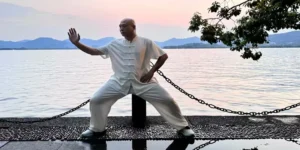Tai Chi and Qigong are often confused due to their origins and similar components. Furthermore, both originated in China and involve the harmonious flow of life energy, mindful movement, breath control, and deep relaxation. These principles, rooted in Taoism and Traditional Chinese Medicine, naturally lead to confusion.
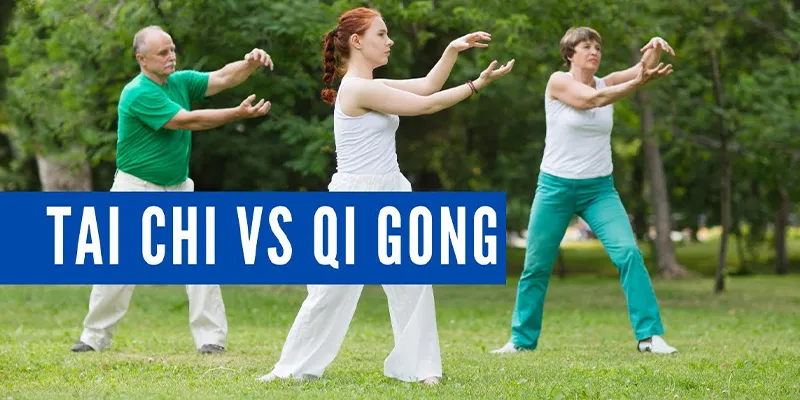
Many people think of Tai Chi as simply Qigong; in fact, they blur the lines between Qigong and Tai Chi. While both arts use Qi for health and harmony, they differ in structure, complexity, application, and historical development: Tai Chi is a sophisticated, complex martial art system, while Qigong is a broader term encompassing thousands of diverse, simpler exercises primarily focused on cultivating and balancing Qi.
This article will show the qi gong vs. tai chi difference, their benefits, and guide you to find authentic tai chi or qigong instruction near you.
What is Tai Chi?
Tai Chi Chuan, commonly shortened to Tai Chi, translates as “Supreme Ultimate Fist.” This name shows its origins: it is first and foremost an internal martial art. Tai chi originated centuries ago in China, its movements were created for self-defense, utilizing principles of yielding, redirecting force, balance, and internal power generation rather than brute strength. While its martial applications are still studied deeply, Tai Chi is globally renowned today for its big health and wellness benefits.
A defining characteristic is its structured forms. Like the popular Yang-style 24-step or Chen style tai chi, both consist of a series of postures linked together in a continuous, slow, graceful flow. Each movement is precise, requiring specific alignments of the feet, legs, torso, arms, and hands. Tai Chi practitioners focus on maintaining a rooted stance, moving with the whole body, regulating the breath smoothly, and cultivating a calm, meditative mind state—the essence of “moving meditation.”

What is Tai Chi typically used for?
- Physical Health: Significantly improves balance and coordination and reduces fall risk, especially in older adults. Tai chi enhances flexibility, joint mobility, and muscular strength. It promotes better body awareness and improves cardiovascular health.
- Mental and Emotional Well-being: Tai chi has been proven to reduce stress, anxiety, and depression. It enhances focus, concentration, and mental clarity. Induces deep relaxation and improves sleep quality.
- Chronic Condition Management: Tai chi is widely recommended for managing pain like arthritis, fibromyalgia, and back pain; improving symptoms of Parkinson’s disease; supporting heart health; and boosting immune function.
- Mind-Body Integration: Tai chi also cultivates a deep connection between physical movement, breath, and mental state.
What is Qigong?
Qigong is pronounced “chee-gong.” The term breaks down to “Qi” (vital energy) and “Gong” (skill through steady practice). Thus, Qigong means “cultivating life energy” or “energy work.” It is also sometimes referred to as Chi Kung, Dao Yin, or Neigong.
Qigong covers a vast and ancient practice aimed at cultivating, balancing, and harmonizing Qi within the body, mind, and spirit. Its roots go back millennia, developed with TCM, Daoist meditation, and Buddhist contemplative practices. Unlike Tai Chi’s forms, Qigong is incredibly diverse.
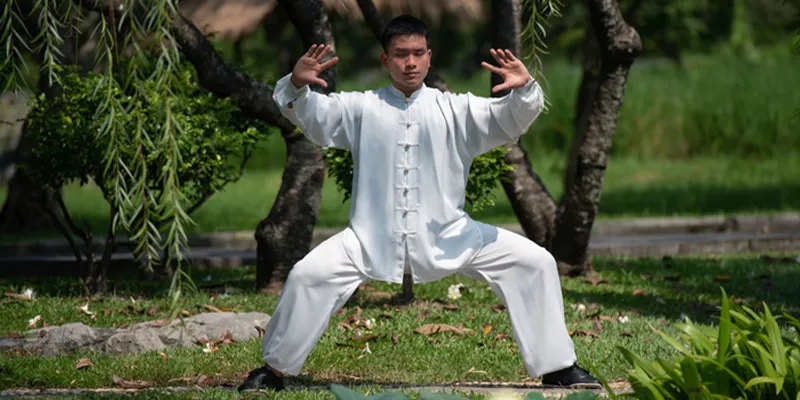
What does Qigong involve?
- Static Postures: Holding specific positions like “Holding the Ball” or “Standing Like a Tree” (Zhan Zhuang) to build structure, root, and circulate Qi.
- Dynamic Movements: Simple, repetitive exercises, often using coordinating breath and movement to guide Qi.
- Meditative Focus and Visualization: Using the mind to guide Qi flow along meridians or to specific organs.
- Self-Massage: Techniques like tapping, rubbing, or acupressure to stimulate Qi flow.
- Sound Healing: Using specific sounds like the Six Healing Sounds to vibrate and influence internal organs and Qi.
Qigong practices range from very simple exercises to complex systems. Its primary goal is health maintenance, healing, vitality enhancement, spiritual development, and achieving harmony within oneself and with the natural world.
Qi Gong vs. Tai Chi: Difference
Difference 1: Nature and Scope
Tai Chi is a specific, complete martial art system with defined styles and forms. Qigong is an energy cultivation practice, but Qigong is not a martial art.
Difference 2: Structure and Complexity
Tai Chi requires learning complex, lengthy sequences. Qigong exercises are generally simpler, often repetitive, and more modular. You can learn a single Qigong exercise quickly; learning a Tai Chi form takes a huge amount of time.
Difference 3: Primary Focus
Tai Chi focuses on martial structure, movement flow, balance, and whole-body integration alongside Qi cultivation. Qigong’s primary focus is directly on cultivating, balancing, and moving Qi.
Difference 4: Learning Curve
Qigong is typically easier to learn due to simpler, repetitive movements. Tai Chi has a difficult learning curve due to sequence complexity and posture detail.
Difference 5: Connotation
Tai Chi reveals martial application, internal power, and energy within its forms. Qigong offers depth through increasingly subtle energy, meditation, and specialized practices.
Difference 6: “Qi” vs. “Chi”
This is purely a romanization difference! “Qi” (in Qigong) and “Chi” (in Tai Chi) represent the exact same concept—the life energy. The spelling “Chi” in Tai Chi Chuan comes from the older Wade-Giles romanization system, while “Qi” in Qigong comes from the modern Pinyin system. It’s the same “Qi.”
Qi Gong vs. Tai Chi: Preparation Before Practice
The preparation before practicing Qigong or Tai Chi is similar.
If you have heart problems, severe osteoporosis, or arthritis, please consult your doctor beforehand to confirm your fitness. If permitted, please maintain your balance as much as possible.
Wear loose, comfortable clothing such as sweatpants/sweatpants, or a T-shirt. Wear flat, soft kung fu slippers, thin-soled sneakers, or practice barefoot.
Also, ensure there is ample space around you to move your arms and legs freely without hitting obstacles.
Stay hydrated. Avoid practicing on a full stomach; it’s recommended to practice 1-2 hours after a meal.
Set a simple goal, such as relaxing, relieving stress, or simply focusing on yourself. This will help you focus and achieve better results.
Qigong vs. Tai Chi: Which is Easier to Learn?
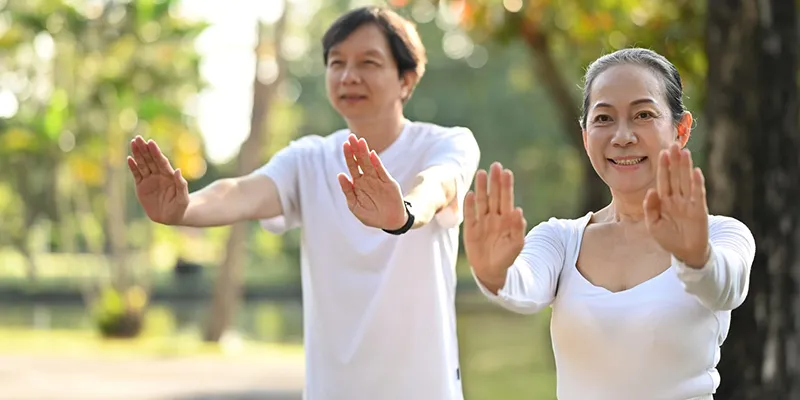
Qigong is easier to learn.
Because qi gong exercises are often short and repetitive. You can learn a beneficial exercise like “Lifting the Sky” or a basic standing meditation in a single session and practice it effectively immediately. No need to memorize long forms. While both can be adapted, many Qigong practices involve less leg movement or weight shifting, making them accessible from seated positions or for those with balance challenges. Qi gong’s primary goal is to focus on breath, sensation, and energy flow.
However, learning a complete Tai Chi form requires memorizing a sequence of often 20, 40, 80, or even 108 postures, each with specific transitions, weight shifts, and directional changes. Each posture demands attention to precise alignment of multiple body parts simultaneously while maintaining continuous flow and root. Achieving the basic short Tai Chi form takes weeks or months of consistent practice, while mastering it takes years.
However, “easier” doesn’t mean “better.” Choose based on your goals:
Seek immediate stress relief, simple energy exercise, or have physical limitations? Qigong is the easier start.
Drawn to a flowing moving meditation, improving complex coordination and balance, or intrigued by martial heritage? Tai Chi, despite the initial challenge, offers a uniquely deep and rewarding journey. Many find the structure itself becomes deeply meditative.
Qigong as the Heart of Tai Chi
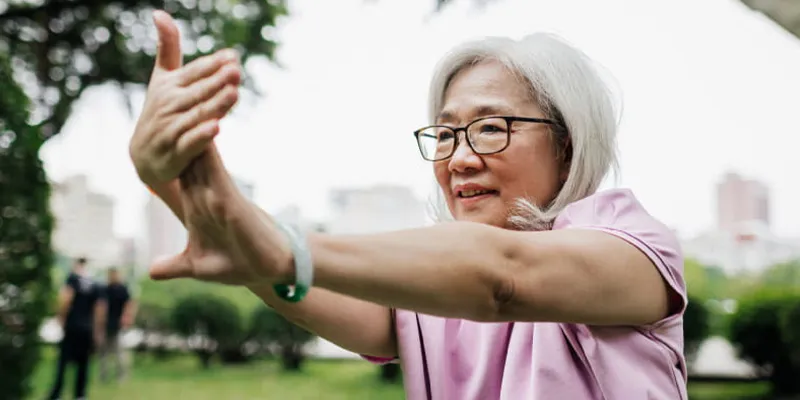
Qigong is not separate from Tai Chi; it is its energetic and foundational core. In fact, Qigong practices are essential preliminary training for Tai Chi:
- Qigong Zhan Zhuang: Builds the crucial root, leg strength, structural alignment, and internal awareness vital for every Tai Chi form.
- Qi Gong Breath Training: Abdominal breathing and breath-movement coordination are essential for Tai Chi’s flow and power generation.
Simple Qigong exercises help practitioners develop sensitivity to Qi and the skill of consciously guiding it. It’s the fundamental to expressing “internal power” in Tai Chi. While Tai Chi movements are designed based on TCM meridian theory and Qi circulation principles central to Qigong. The graceful tai chi forms and spirals facilitate Qi flow.
And advanced Tai Chi practice involves deep Qigong within the form. Practitioners move beyond external shape to consciously guide Qi, open and close joints energetically, and connect breath and intention with movement to generate profound internal power and therapeutic effect. Without this Qigong layer, Tai Chi risks becoming an empty dance.
Find Authentic Tai Chi or Qigong Classes
Search for reputable Tai Chi or Qigong schools in your area. Many have clear websites detailing styles taught, instructor qualifications, class schedules, and introductory offers.
Look for national/international association directories, such as the Tai Chi for Health Institute, the National Qigong Association, and the British Tai Chi Chuan Federation, which often list certified tai chi instructors.
Mindbody and ClassPass often list local Tai Chi and Qigong classes. Filter by location and activity. Check instructor bios and studio websites linked.
Many recreation centers, YMCAs, and health clubs offer classes. You can check their online activity schedules.
Google Maps & Search: A simple “Tai Chi classes near me” or “Qigong instruction [Your City]” search remains powerful. Google Maps often shows locations, reviews, and links to websites. Scrutinize results: Look beyond ads to organic listings.
Social Media:
- Facebook: Search for groups like “Tai Chi in [Your City]” or “Qigong Practitioners [Your Region].” Check local community group posts. Look for studio/instructor pages.
- Meetup: This platform is excellent for finding local practice groups and classes. Search for “Tai Chi” or “Qigong.”
Online Directories:
- The World Tai Chi and Qigong Day website (worldtaichiday.org) : provides a global event map; instructors/organizations hosting events often teach year-round.
- Qigong Institute Directory (qigonginstitute.org/directory): lists instructors and resources (primarily US-focused but international).
Video Platforms: While not for finding local classes directly, YouTube or Vimeo can be useful. Search for instructors in your area; they may have promotional videos or links to their local school website. Avoid relying solely on online videos for learning as a beginner; get in-person correction.
Many schools offer a free or discounted first class. Use this to assess the teacher and environment.

